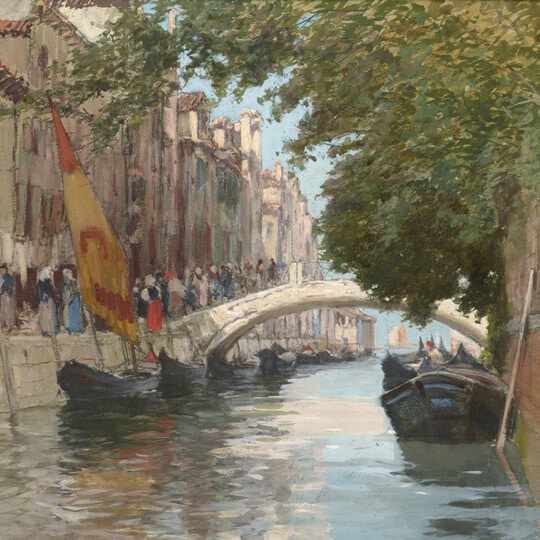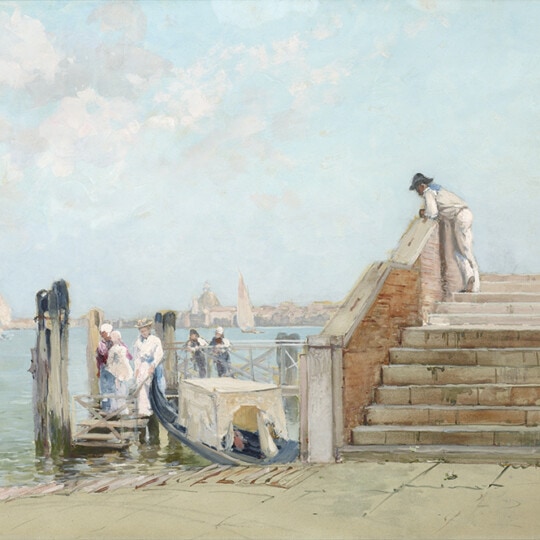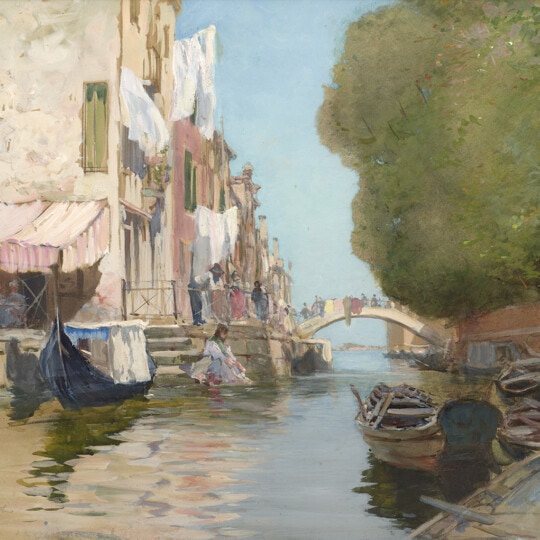Artist Biography
It takes a great man to do one thing well; Mr. Smith can do several excellently, as well as paint admirable pictures.[1]
By Nina Sangimino
I. Biography
II. Chronology
III. Collections
IV. Exhibitions
V. Memberships
VI. Notes
VIII. Suggested Resources
I. Biography
Renaissance-man Francis Hopkinson Smith was born in Baltimore, Maryland on October 23, 1838. His lineage includes a signer of the Declaration of Independence and the first president of the Pennsylvania Academy of the Fine Arts.[2] This self-taught artist started
It takes a great man to do one thing well; Mr. Smith can do several excellently, as well as paint admirable pictures.[1]
By Nina Sangimino
I. Biography
II. Chronology
III. Collections
IV. Exhibitions
V. Memberships
VI. Notes
VIII. Suggested Resources
I. Biography
Renaissance-man Francis Hopkinson Smith was born in Baltimore, Maryland on October 23, 1838. His lineage includes a signer of the Declaration of Independence and the first president of the Pennsylvania Academy of the Fine Arts.[2] This self-taught artist started sketching the Maryland countryside on weekends in his teens, yet began his career as a naval engineer and worked on such prestigious projects as the Race Rock Lighthouse off Block Island and the foundation for the Statue of Liberty.[3] By the 1880s he left engineering to pursue painting, which up until that time had not been more than a hobby. He became a successful plein-air landscape painter—boasting that he had never completed a “studio picture” in his life[ 4]—most well known for compositions in charcoal and watercolor. As stated in a contemporary article on the artist:
Mr. Smith excels in charcoal, which he prefers to lead, to oils, or to water-colours…the process possesses precious advantages for the skilled draughtsman, and combines some of the characteristics of paintings with all those proper to drawing with chalk, great felicity, richness of colour, and unusual freedom.[5]
In 1863 Smith visited the White Mountains in New Hampshire for the first time, and continued to summer there annually for at least fifteen years. Just as the area was becoming a popular tourist location, Smith became known as the most prolific artist of White Mountain views, specializing in unique locations off the main tourist trails. After devoting himself to art in the 1880s, he began traveling to Europe rather than the White Mountains, and garnered the most fame of his career as a painter of popular destinations abroad, especially Venice.
As well as being known for his work in civil engineering and his landscape drawings, Smith was also a successful author. Some of the many books authored by Smith, both fiction and non-fiction, include Colonel Carter of Cartersville (1891), Gondola Days (1897), The Fortunes of Oliver Horn (1902), and In Dickens’s London (1914). Later in life Smith became part of an artists’ colony at Cold Spring Harbor, Long Island with fellow artists Arthur Quartley and Charles Stanley Reinhart. Despite his rather wide-spread fame and success during his lifetime, his name diminished after his death as Modernism came into favor. He continued to paint, publish, and exhibit right up until the end of his life.
II. Chronology
1838 Born October 23 in Baltimore, Maryland
1861 Moved to New York City and worked as a clerk in an iron house
1863 Began spending summers in the White Mountains and later became known as the most prolific artist of views of the region
1866 Married Josephine Van Deventer
1867 Summer in the Woods included in inaugural exhibition of American Watercolor Society; first exhibition for the artist
1869 Elected member of American Watercolor Society
1873 Elected member of Century Club
1874 Made treasurer of American Watercolor Society
1876 Exhibited four watercolors of the White Mountains at the Centennial Exhibition in Philadelphia, gaining praise for the work In a Darling Wood Amid the Cool and Silence
1877 Member of various important committees during the Loan Exhibition of the Society of Decorative Art in the National Academy of Design
1884 Returned to New York from first trip to Europe
1891 Publication of Colonel Carter of Cartersville, Smith’s first successful novel
1896 Published a portfolio of nearly two hundred drawings titled Venice of Today
1898 Awarded Commander Order of the Mejidieh
1900 Awarded Order of Osmanieh
1906 Joined Society of Illustrators
1915 Died April 7 in New York City
III. Collections
Albright-Knox Art Gallery, NY
Art Center for Southwestern Louisiana, LA
Brooklyn Museum, NY
Cooper-Hewitt National Design Museum, NY
Corcoran Gallery of Art, Washington, DC
Museum of the City of New York, NY
National Portrait Gallery, Washington, DC
The Nelson-Atkins Museum of Art, MO
Reading Public Museum, PA
Santa Barbara Museum of Art, CA
Syracuse University, University Art Collection, NY
University of Virginia, VA
The Walters Art Museum, MD
Washington County Museum of Fine Arts, MD
IV. Exhibitions
1868, 1880 National Academy of Design
1875–84, 1891 Brooklyn Art Association
1876 Centennial Exhibition
1879–80, 1892, 1900 Pennsylvania Academy of the Fine Arts, Annuals
1880–1905 Boston Art Club
1889–1908 Art Institute of Chicago
1901 Pan-American Exposition, Buffalo, bronze medal
1902 Charleston Exposition, medal
Philadelphia Art Club, gold medal
American Art Society, Philadelphia, gold medal
1915 Albright Art Gallery, Buffalo Fine Arts Academy, solo exhibition
1984 Cooper-Hewitt National Design Museum
V. Memberships
American Water Color Society, treasurer 1874–78
Century Association
Cincinnati Art Club
National Institute of Arts and Letters
New York Etching Club
Palette Club
Philadelphia Art Club
Society of Illustrators
Tile Club, founding member
VI. Notes
1. “F. Hopkinson Smith,” Art and Progress 6, no. 8 (June, 1915): 284.
2. “American Painters. Walter Shirlaw and F. Hopkinson Smith,” The Art Journal 4 (1878): 362.
3. Nick Madormo, “Francis Hopkinson Smith (1838-1915): His Drawings of the White Mountains and Venice,” American Art Journal 17, no. 1 (Winter, 1985): 68.
4. Ibid, 80.
5. “American Painters”: 363.
VII. Suggested Resources
“American Painters. Walter Shirlaw and F. Hopkinson Smith.” The Art Journal 4 (1878): 360–3.
“F. Hopkinson Smith.” Art and Progress 6, no. 8 (June, 1915): 284–5.
Campbell, Catherine H. New Hampshire Scenery: A Dictionary of Nineteenth-Century Artists of New Hampshipe Landscapes. Canaan, New Hampshire: Phoenix Publishing for the New Hampshire Historical Society, 1985, pp. 150–1.
Dee, Elaine Evans. Nineteenth-Century American Landscape Drawings. New York, 1982, pp. 34–5.
Falk, Peter Hastings, ed. Who Was Who in American Art: 1564–1975, vol. III. Madison, Connecticut: Sound View Press, 1999, p. 3076
Fuller-Walker. “Francis Hopkinson Smith.” The Aldine 9, no. 6 (1878): 195–8.
Madormo, Nick. “Francis Hopkinson Smith (1838–1915): His Drawings of the White Mountains and Venice.” American Art Journal 17, no. 1 (Winter, 1985): 68–81.
The Francis Hopkinson Smith Papers, Archives of American Art, Smithsonian Institution, Washington, DC.
It takes a great man to do one thing well; Mr. Smith can do several excellently, as well as paint admirable pictures.[1]
By Nina Sangimino
I. Biography
II. Chronology
III. Collections
IV. Exhibitions
V. Memberships
VI. Notes
VIII. Suggested Resources
I. Biography
Renaissance-man Francis Hopkinson Smith was born in Baltimore, Maryland on October 23, 1838. His lineage includes a signer of the Declaration of Independence and the first president of the Pennsylvania Academy of the Fine Arts.[2] This self-taught artist started sketching the Maryland countryside on weekends in his teens, yet began his career as a naval engineer and worked on such prestigious projects as the Race Rock Lighthouse off Block Island and the foundation for the Statue of Liberty.[3] By the 1880s he left engineering to pursue painting, which up until that time had not been more than a hobby. He became a successful plein-air landscape painter—boasting that he had never completed a “studio picture” in his life[ 4]—most well known for compositions in charcoal and watercolor. As stated in a contemporary article on the artist:
Mr. Smith excels in charcoal, which he prefers to lead, to oils, or to water-colours…the process possesses precious advantages for the skilled draughtsman, and combines some of the characteristics of paintings with all those proper to drawing with chalk, great felicity, richness of colour, and unusual freedom.[5]
In 1863 Smith visited the White Mountains in New Hampshire for the first time, and continued to summer there annually for at least fifteen years. Just as the area was becoming a popular tourist location, Smith became known as the most prolific artist of White Mountain views, specializing in unique locations off the main tourist trails. After devoting himself to art in the 1880s, he began traveling to Europe rather than the White Mountains, and garnered the most fame of his career as a painter of popular destinations abroad, especially Venice.
As well as being known for his work in civil engineering and his landscape drawings, Smith was also a successful author. Some of the many books authored by Smith, both fiction and non-fiction, include Colonel Carter of Cartersville (1891), Gondola Days (1897), The Fortunes of Oliver Horn (1902), and In Dickens’s London (1914). Later in life Smith became part of an artists’ colony at Cold Spring Harbor, Long Island with fellow artists Arthur Quartley and Charles Stanley Reinhart. Despite his rather wide-spread fame and success during his lifetime, his name diminished after his death as Modernism came into favor. He continued to paint, publish, and exhibit right up until the end of his life.
II. Chronology
1838 Born October 23 in Baltimore, Maryland
1861 Moved to New York City and worked as a clerk in an iron house
1863 Began spending summers in the White Mountains and later became known as the most prolific artist of views of the region
1866 Married Josephine Van Deventer
1867 Summer in the Woods included in inaugural exhibition of American Watercolor Society; first exhibition for the artist
1869 Elected member of American Watercolor Society
1873 Elected member of Century Club
1874 Made treasurer of American Watercolor Society
1876 Exhibited four watercolors of the White Mountains at the Centennial Exhibition in Philadelphia, gaining praise for the work In a Darling Wood Amid the Cool and Silence
1877 Member of various important committees during the Loan Exhibition of the Society of Decorative Art in the National Academy of Design
1884 Returned to New York from first trip to Europe
1891 Publication of Colonel Carter of Cartersville, Smith’s first successful novel
1896 Published a portfolio of nearly two hundred drawings titled Venice of Today
1898 Awarded Commander Order of the Mejidieh
1900 Awarded Order of Osmanieh
1906 Joined Society of Illustrators
1915 Died April 7 in New York City
III. Collections
Albright-Knox Art Gallery, NY
Art Center for Southwestern Louisiana, LA
Brooklyn Museum, NY
Cooper-Hewitt National Design Museum, NY
Corcoran Gallery of Art, Washington, DC
Museum of the City of New York, NY
National Portrait Gallery, Washington, DC
The Nelson-Atkins Museum of Art, MO
Reading Public Museum, PA
Santa Barbara Museum of Art, CA
Syracuse University, University Art Collection, NY
University of Virginia, VA
The Walters Art Museum, MD
Washington County Museum of Fine Arts, MD
IV. Exhibitions
1868, 1880 National Academy of Design
1875–84, 1891 Brooklyn Art Association
1876 Centennial Exhibition
1879–80, 1892, 1900 Pennsylvania Academy of the Fine Arts, Annuals
1880–1905 Boston Art Club
1889–1908 Art Institute of Chicago
1901 Pan-American Exposition, Buffalo, bronze medal
1902 Charleston Exposition, medal
Philadelphia Art Club, gold medal
American Art Society, Philadelphia, gold medal
1915 Albright Art Gallery, Buffalo Fine Arts Academy, solo exhibition
1984 Cooper-Hewitt National Design Museum
V. Memberships
American Water Color Society, treasurer 1874–78
Century Association
Cincinnati Art Club
National Institute of Arts and Letters
New York Etching Club
Palette Club
Philadelphia Art Club
Society of Illustrators
Tile Club, founding member
VI. Notes
1. “F. Hopkinson Smith,” Art and Progress 6, no. 8 (June, 1915): 284.
2. “American Painters. Walter Shirlaw and F. Hopkinson Smith,” The Art Journal 4 (1878): 362.
3. Nick Madormo, “Francis Hopkinson Smith (1838-1915): His Drawings of the White Mountains and Venice,” American Art Journal 17, no. 1 (Winter, 1985): 68.
4. Ibid, 80.
5. “American Painters”: 363.
VII. Suggested Resources
“American Painters. Walter Shirlaw and F. Hopkinson Smith.” The Art Journal 4 (1878): 360–3.
“F. Hopkinson Smith.” Art and Progress 6, no. 8 (June, 1915): 284–5.
Campbell, Catherine H. New Hampshire Scenery: A Dictionary of Nineteenth-Century Artists of New Hampshipe Landscapes. Canaan, New Hampshire: Phoenix Publishing for the New Hampshire Historical Society, 1985, pp. 150–1.
Dee, Elaine Evans. Nineteenth-Century American Landscape Drawings. New York, 1982, pp. 34–5.
Falk, Peter Hastings, ed. Who Was Who in American Art: 1564–1975, vol. III. Madison, Connecticut: Sound View Press, 1999, p. 3076
Fuller-Walker. “Francis Hopkinson Smith.” The Aldine 9, no. 6 (1878): 195–8.
Madormo, Nick. “Francis Hopkinson Smith (1838–1915): His Drawings of the White Mountains and Venice.” American Art Journal 17, no. 1 (Winter, 1985): 68–81.
The Francis Hopkinson Smith Papers, Archives of American Art, Smithsonian Institution, Washington, DC.



